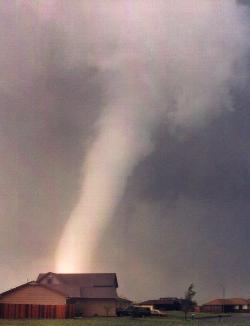
If you've read Jude's section "Blowing in the solar wind", then you'll know that there's a wind that blows out from the Sun's surface into space.
What happens when this wind hits the Earth?
The solar wind is moving very fast (over 1 million km/h), and so you'd think it would cause a lot of damage, like a tornado or a hurricane.

If tornadoes like the one above cause so much damage with wind speeds of a few hundred kilometres an hour, how come the solar wind isn't disastrous?
Fortunately we're saved by the Earth's magnetic field, which acts like a protective bubble and forces the solar wind to go around the Earth.
OK, so what about the northern lights?
The magnetic field is again important. The solar wind carries not only some of the Sun's material, but also some of its magnetic field.
Remember that a magnet has a 'direction' (think of the north and south poles). In the same way, the solar wind's magnetic field has a direction.
If the direction of the Earth's and the solar wind's magnetic field are opposite to each other, then they can cancel each other out. A bit of the Earth's magnetic field "snaps" and, like an elastic band, flings particles towards the Earth's surface.
Now remember what I said in the last section. Aurorae are a bit like your television screen. The particles that are flung towards the Earth bash into the nitrogen and oxygen atomes in the air and make them glow in different colours.

|